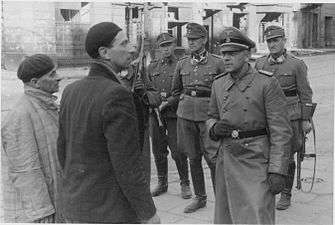Maximilian von Herff
| Maximilian von Herff | |
|---|---|
|
Herff (front right) during the Warsaw Ghetto Uprising | |
| Born |
17 April 1893 Hanover, Germany |
| Died |
6 September 1945 (aged 52) Conishead Priory, Ulverston, England |
| Buried at | Cannock Chase German war cemetery |
| Allegiance |
|
| Service/branch | Heer, Waffen-SS |
| Rank |
|
| Unit |
|
| Commands held | Chef des Personalamtes der Waffen-SS |
| Battles/wars | |
| Awards | Knight's Cross of the Iron Cross |
Maximilian von Herff (17 April 1893 – 6 September 1945) was a German army officer and Schutzstaffel (SS) General.
World War I
He was born in Hanover, the son of a physician. He joined the Imperial Army in August 1914 and was commissioned as a leutnant (lieutenant) in the Grand Duchy of Hesse 1st Life Guards Regiment (115th Infantry). He served in this regiment through most of World War I. Later he served in the Fifth Lower Silesian Regiment (154th Infantry), and remained in that unit until 9 November 1918. During his service he was awarded the Iron Cross First and Second Class.
Between the wars
Between 1 March and 1 October 1919 he was a volunteer in the Hanoverian Freikorps and then joined the Reichswehr. He married Hedwig von Grolman on 4 August 1920. In 1926 he joined the 18th Cavalry Regiment in Stuttgart, and on 1 February 1928 joined the 15th Infantry Regiment in Kassel. On 1 February 1928 he was promoted to Hauptmann (captain) and on 1 October 1934 to major.
On 16 March 1935 he was appointed to the staff of the Eighth Corps in Breslau. He was promoted to Oberstleutnant (lieutenant colonel) on 1 August 1937. On 3 January 1939 was appointed to the staff of the Seventeenth Corps in Vienna.
World War II
During World War II, Herff served with the Deutsches Afrika Korps in North Africa. He was promoted to Oberst (colonel) and commanded "Kampfgruppe von Herff". For his service in North Africa he was awarded the Knight's Cross of the Iron Cross in June 1941.
At the suggestion of Heinrich Himmler he transferred to the Waffen-SS. On 1 April 1942 Herff joined the Nazi Party (member no. 8 858 661) and the SS (member no. 405 894). From 1 October 1942 to 8 May 1945, he was chief of the Persönlicher Stab Reichsführer-SS (Himmler's personal staff). He dealt with internal and financial SS matters.
In his later diary entries, Herff would claim to have had knowledge of the Final Solution but not have played any role in administrative or actual involvement in exterminations or deportations. However, on 14–15 May 1943, Von Herff was in Warsaw during the Warsaw Ghetto Uprising and supervised its suppression under orders from Himmler. His adjutant, Karl Kaleske wrote of the deportations carried out following the uprising to Auschwitz concentration camp and other camps where "special action" was required. Jürgen Stroop's report on the The Warsaw Ghetto Uprising contains a photograph of Herff and Stroop taken during the May 1943 visit. {See upper right hand quarter}
On 20 April 1944, Herff was promoted to SS-Obergruppenführer (SS general).
Capture and death
He was captured by British forces in 1945, and held at Grizedale Hall POW camp. He suffered a stroke and died at nearby Conishead Priory Military Hospital. He was later reburied at Cannock Chase German war cemetery, Staffordshire.
His sister Carin von Herff moved to London during his imprisonment where she would live for four years before returning to Germany with her French Huguenot husband, a former SS-Oberführer of the 33rd Waffen Grenadier Division of the SS Charlemagne (1st French).[1] Both were acquitted of any war crimes and along with Maximilian von Herff claim they were only involved in the Nazi Party base and Waffen-SS[2] not the extermination of the Jews. The couple would later return to live in England in the 1960s.
Awards
- Knight's Cross of the Iron Cross on 13 June 1941 as Oberst and leader of Kampfgruppe "von Herff" (Schützen-Regiment 115) in the DAK[3][Note 1]
See also
Notes
The photo shown is NOT one of Maximilian von Herff. The man in the leather greatcoat appears to be an SS-Obersturmführer. ~ Mike Miller (Author, "Leaders of the SS & German Police" Volumes 1 and 2, the latter featuring a biography of von Herff; both published by R. James Bender Publishing, 2006 and 2015, respectively)
References
Citations
- ↑ "The USA and us"-"The sins of the forefathers" J. Andreani,
- ↑ http://www.fpp.co.uk/Auschwitz/docs/controversies/Franke_Griksch/Tgb_Herff_1945.html
- ↑ Fellgiebel 2000, p. 223.
- ↑ Scherzer 2007, p. 384.
Bibliography
- Fellgiebel, Walther-Peer (2000) [1986]. Die Träger des Ritterkreuzes des Eisernen Kreuzes 1939–1945 — Die Inhaber der höchsten Auszeichnung des Zweiten Weltkrieges aller Wehrmachtteile [The Bearers of the Knight's Cross of the Iron Cross 1939–1945 — The Owners of the Highest Award of the Second World War of all Wehrmacht Branches] (in German). Friedberg, Germany: Podzun-Pallas. ISBN 978-3-7909-0284-6.
- Scherzer, Veit (2007). Die Ritterkreuzträger 1939–1945 Die Inhaber des Ritterkreuzes des Eisernen Kreuzes 1939 von Heer, Luftwaffe, Kriegsmarine, Waffen-SS, Volkssturm sowie mit Deutschland verbündeter Streitkräfte nach den Unterlagen des Bundesarchives [The Knight's Cross Bearers 1939–1945 The Holders of the Knight's Cross of the Iron Cross 1939 by Army, Air Force, Navy, Waffen-SS, Volkssturm and Allied Forces with Germany According to the Documents of the Federal Archives] (in German). Jena, Germany: Scherzers Militaer-Verlag. ISBN 978-3-938845-17-2.
